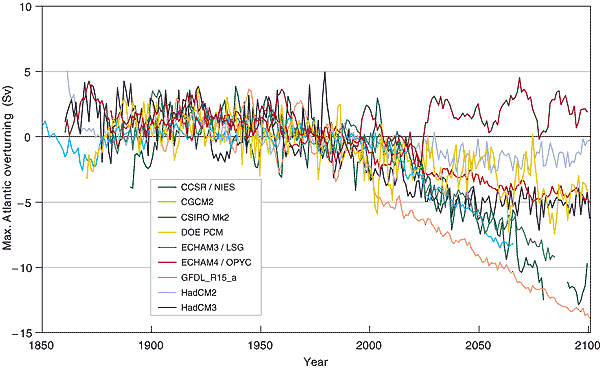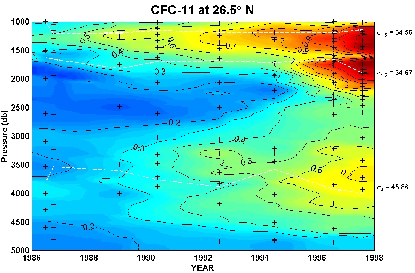Climate models have suggested that the large scale ocean circulation plays an important role in redistributing heat, mass and fresh water. In the Atlantic, about 1.2 PW of heat is carried northward with the subtropical gyre. This represents about 60% of the total northward heat flux within the ocean and between 30-50% of the total heat transport within the ocean-atmosphere system. In the ocean, the transport is largely carried by the meridional overturning circulation (MOC) which is dominated by near surface warm waters carried within the Florida Current (further north, the Gulf Stream) and returned southward as the deep cold Deep Western Boundary Current. Numerical models have predicted substantial fluctuations in the MOC transport of mass and heat in interannual and decadal time scales.

Model estimated changes in MOC transport in the Atlantic for a range of global warming scenarios computed by different climate research centers. Shown is the annual anomaly relative to the mean of the model years 1961 to 1990 (Unit: SV, 106 m3s-1). (IPCC, 2001 their Fig. 9.21)
Observations within the ocean have also suggested large interannual changes in the water properties and sources of the deep water (e.g. Curry and McCartney, 2001; Bonisch et al. 1997). For example, pulses of deep Labrador Sea Water have been seen crossing the NOAA/OGP funded Deep Western Boundary Current Time Series.

Transient tracer time series of chloroflourocarbon (CFC11) shows the variability in the Deep Western Boundary Current composition.
However, the effect on meridional transport of heat is yet to be determined. So while the MOC variability appears to be an important element within climate change scenarios, no observational system is in place to observe its changes. From a National Academy report on climate change (National Research Council, 2002):
"If we are to develop the ability to predict changes in the MOC, we must observe its strength and structure as a fundamental requirement, akin to the necessity to observe the equatorial Pacific if one wants to forecast El Nino."
That way the main objective of the MOCHA project is to put in place an observing system in the subtropical North Atlantic to quantify the net meridional transport of mass and heat with which the variability of the thermohaline circulation can be monitored to assess its relationship to climate fluctuations and evaluate climate predictions.

